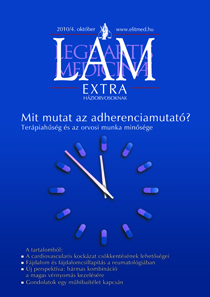The eLitMed.hu medical portal uses computer cookies for convenient operation. Detailed information can be found in the Cookie-policy.
LAM Extra for General Practicioners - 2010;2(04)
Content
[CARDIOVASCULAR PREVENTION OPPORTUNITIES OF RISK REDUCTION, 2010]
[10 years of experience following the millennium has confirmed again that data on long term cardiovascular morbidity and mortality can be influenced by effective prevention most substantially. Growing body of knowledge and experience in the field of modern cardiovascular prevention is available, but novel and novel milestone studies have been published leading to updating of guidelines, however, we cannot be satisfied with the results. Evidence suggest that despite recent efforts, Hungarian cardiovascular morbidity and mortality has not been reduced significantly and except for some success - acute ST elevation myocardial infarction care in accordance with the European standard - we are behind the other EU countries in cardiovascular mortality of the active (age 30-65 years) age group. Recently several interesting contradiction has been published in the field of prevention, like the effectiveness of aspirin as primer prevention, which changes our common prevention conception. Data have to be also addressed, which can explain the controversial results from a different point of view. Now we are talking about the results of REALITY study, which highlight not only the noncompliance of the patient but that of the physician as well.]
[PAIN AND PAIN CONTROL IN RHEUMATOLOGY]
[In developed industrial countries the overall population prevalence of chronic rheumatic pain is around 35%. A classification that is useful in everyday practice is based on the origin of musculoskeletal pain and lists pain associated with degenerative joint diseases, pain related to metabolic bone diseases, non-articular and soft tissue rheumatism, and pain due to inflammation. In chronic pain syndrome pain itself has lost its adaptive biological role, and presents as a pathogenetic factor in its own right, accompanied by significant vegetative and psychological symptoms. Therapeutic exercise is of basic importance in the management of rheumatic pain. It is supplemented by various pharmacologic and nonpharmacologic methods. The latter include, among others, fomentations, packs, balneo- and hydrotherapeutic methods, electro-, mechanoand thermotherapeutic approaches. Pharmacological therapy usually means the use of simple analgesics, non-steroidal antiinflammatory drugs, steroids, minor opiates, and, lately, also major opiates, which may be supplemented by adjuvant agents such as tricyclic antidepressants and anticonvulsive drugs. When indicating the most often used non-steroidal antiinflammatory drugs, their potential side effects should carefully be considered. Invasive pain-killing methods on the border area between anaesthesiology and rheumatology (epidural steroid administration, ganglionic blockade, intravenous regional blockade) are applied in cases that do not respond to conventional therapy, and sometimes also as successful first-line intervention.]
[MODERN BETA-BLOCKER THERAPY FROM THE CARDIOLOGIST’S VIEWPOINT]
[Following the publication of some large, randomised trials (LIFE, ASCOT), the benefits of the use of beta-blockers in hypertension have been questioned. On the basis of these clinical trials it has been posited that beta-blockers administered for the treatment of hypertonia are less effecient for stroke prevention. It has been suggested that first-generation beta-blockers (atenolol) have adverse metabolic effects (insulin sensitivity, lipid parameteres), which might contribute to the differences observed in clinical outcomes. On the basis of a number of clinical trials and meta-analyses performed in recent years it is now evident that the most important goal is to reach target blood pressure levels, which is usually achieved by combination therapy. Choosing drugs on the basis of strict protocols is less important. In general, beta-blockers remain one of the most important drug class for the treatment of hypertension. The author reviews the pharmacology of the cardioselective, vasodilatory drug nebivolol in detail, as well as clinical trials on nebivolol. Nebivolol has a neutral (or rather beneficial) effect on metabolic parameters (lipid parameters, blood glucose level and insulin sensitivity) as well as on left ventricular function. If hypertension is associated with cardiovascular diseases (left ventricular dysfunction, ischaemic hears disease, atrial fibrillation), nebivolol offers an excellent therapeutic alternative due to its excellent tolerability and side effect profile]
[CARVEDILOL AND ITS ANTIOXIDANT EFFECT]
[Carvedilol, the typical basic variant of the third generation beta blocker drugs is a complex adrenergic blocker that also has Ca channel blocking effects. It has no effect of the metabolism and has a pregnant antioxidant effect that is significant for cardiac and hypertension target organ protection. Its beneficial effect on cardiac decompensation, on target organ protection in patients with hypertension and on primary and secondary prevention of ischemic heart disease is proven by clinical studies. The effect of free radicals trapping - not shown by the majority of beta blockers - plays a major role in these beneficial effects. Inflammatory factors and free radicals (ROS) play a central role in cardiovascular diseases and can be regarded as prognostic markers of vascular damage. Elevated levels of glucose, lipids, or elevated intraluminal pressure triggers the production of various free radicals. The anti-inflammatory effect of carvedilol results out of its antioxidant (scavenger) and ROS suppressive effects. Besides its complex adrenergic blocking effect, this ability of carvedilol gives a molecular explanation for its efficiency proven by clinical trials.]
1.
Clinical Neuroscience
[Headache registry in Szeged: Experiences regarding to migraine patients]2.
Clinical Neuroscience
[The new target population of stroke awareness campaign: Kindergarten students ]3.
Clinical Neuroscience
Is there any difference in mortality rates of atrial fibrillation detected before or after ischemic stroke?4.
Clinical Neuroscience
Factors influencing the level of stigma in Parkinson’s disease in western Turkey5.
Clinical Neuroscience
[The effects of demographic and clinical factors on the severity of poststroke aphasia]1.
2.
Clinical Oncology
[Pancreatic cancer: ESMO Clinical Practice Guideline for diagnosis, treatment and follow-up]3.
Clinical Oncology
[Pharmacovigilance landscape – Lessons from the past and opportunities for future]4.
5.



